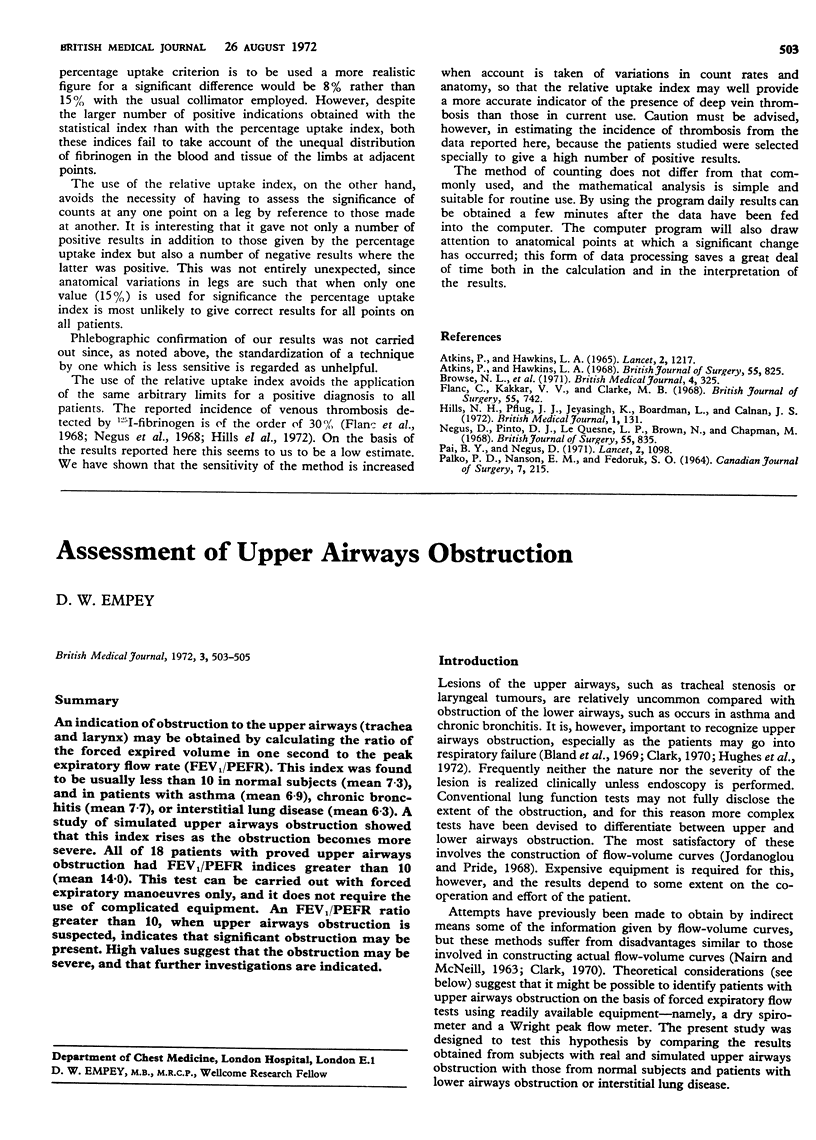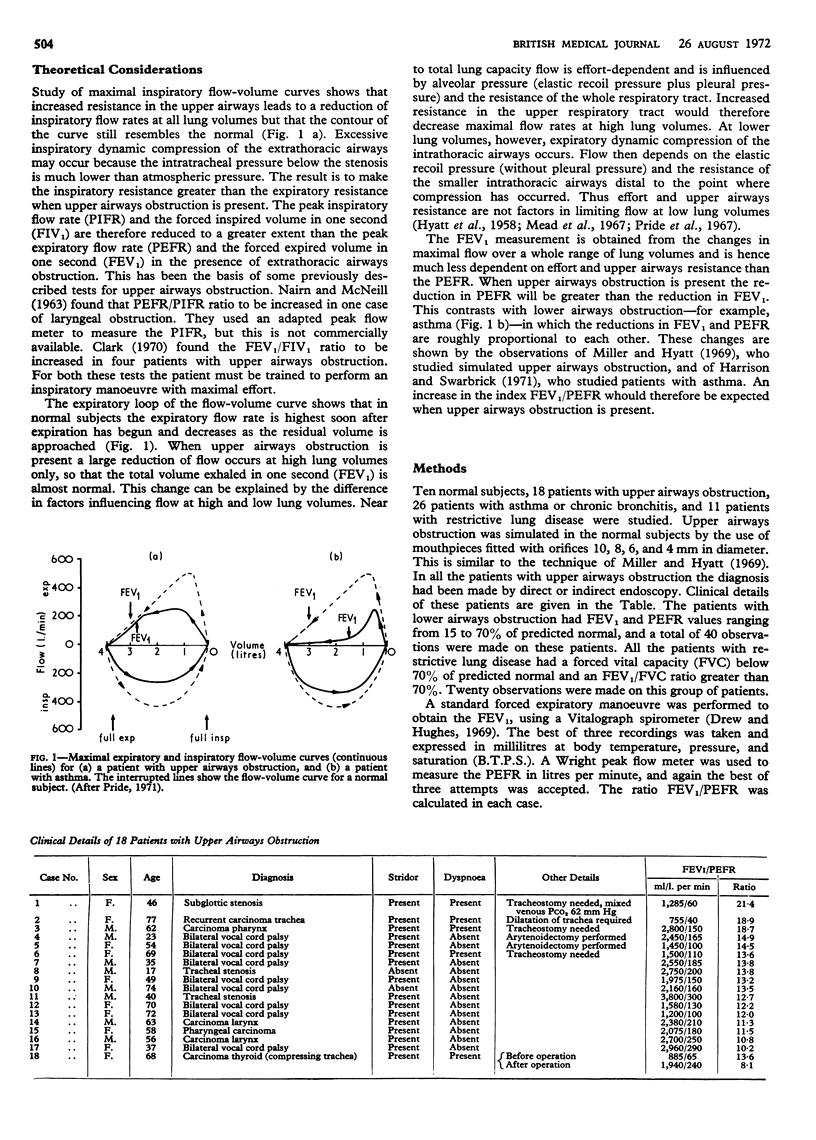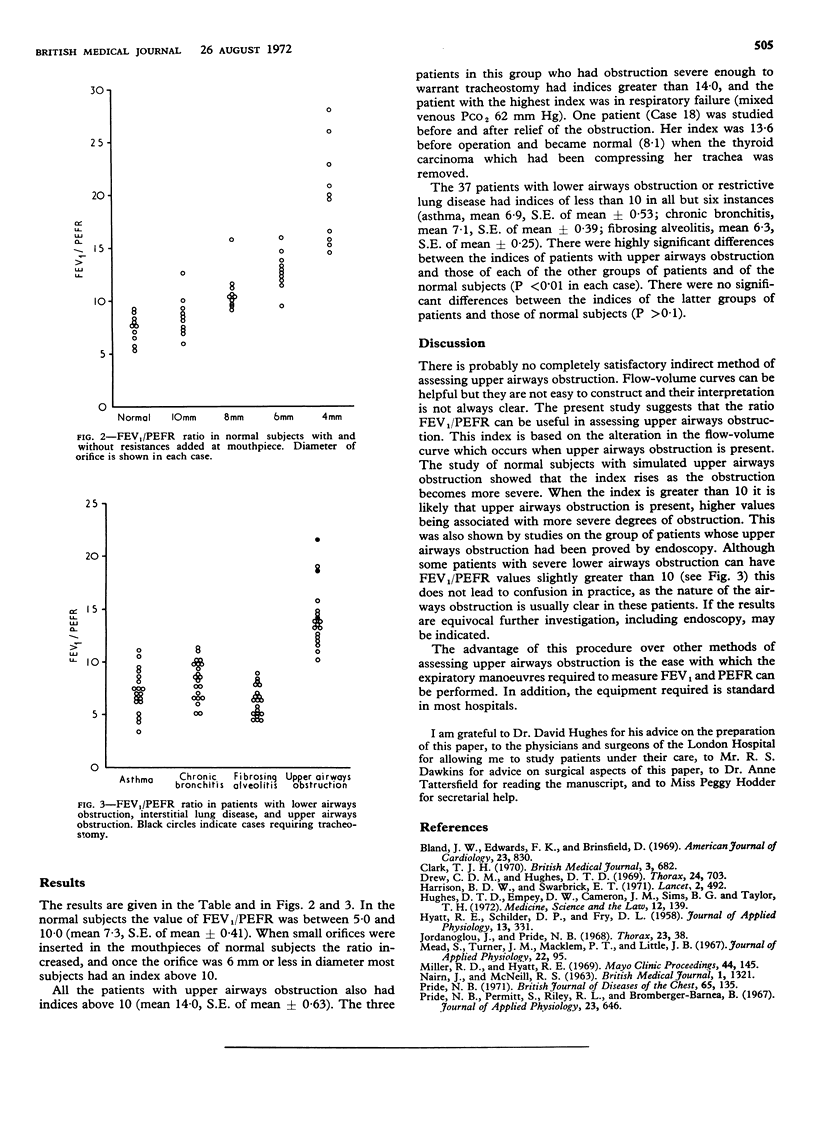Abstract
An indication of obstruction to the upper airways (trachea and larynx) may be obtained by calculating the ratio of the forced expired volume in one second to the peak expiratory flow rate (FEV1/PEFR). This index was found to be usually less than 10 in normal subjects (mean 7·3), and in patients with asthma (mean 6·9), chronic bronchitis (mean 7·7), or interstitial lung disease (mean 6·3). A study of simulated upper airways obstruction showed that this index rises as the obstruction becomes more severe. All of 18 patients with proved upper airways obstruction had FEV1/PEFR indices greater than 10 (mean 14·0). This test can be carried out with forced expiratory manoeuvres only, and it does not require the use of complicated equipment. An FEV1/PEFR ratio greater than 10, when upper airways obstruction is suspected, indicates that significant obstruction may be present. High values suggest that the obstruction may be severe, and that further investigations are indicated.
Full text
PDF


Selected References
These references are in PubMed. This may not be the complete list of references from this article.
- Bland J. W., Jr, Edwards F. K. Pulmonary hypertension and congestive heart failure in children with chronic upper airway obstruction. New concepts of etiologic factors. Am J Cardiol. 1969 Jun;23(6):830–837. doi: 10.1016/0002-9149(69)90378-6. [DOI] [PubMed] [Google Scholar]
- Clark T. J. Inspiratory obstruction. Br Med J. 1970 Sep 19;3(5724):682–684. doi: 10.1136/bmj.3.5724.682. [DOI] [PMC free article] [PubMed] [Google Scholar]
- Drew C. D., Hughes D. T. Characteristics of the Vitalograph spirometer. Thorax. 1969 Nov;24(6):703–706. doi: 10.1136/thx.24.6.703. [DOI] [PMC free article] [PubMed] [Google Scholar]
- HYATT R. E., SCHILDER D. P., FRY D. L. Relationship between maximum expiratory flow and degree of lung inflation. J Appl Physiol. 1958 Nov;13(3):331–336. doi: 10.1152/jappl.1958.13.3.331. [DOI] [PubMed] [Google Scholar]
- Harrison B. D., Swarbrick E. T. Peak-flow percentage in asthma. Lancet. 1971 Aug 28;2(7722):492–492. doi: 10.1016/s0140-6736(71)92659-6. [DOI] [PubMed] [Google Scholar]
- Hughes D. T., Empey D. W., Cameron J. M., Sims B. G., Taylor T. H. Immediate postoperative death associated with severe laryngeal obstruction. Med Sci Law. 1972 Apr;12(2):139–141. doi: 10.1177/002580247201200213. [DOI] [PubMed] [Google Scholar]
- Jordanoglou J., Pride N. B. A comparison of maximum inspiratory and expiratory flow in health and in lung disease. Thorax. 1968 Jan;23(1):38–45. doi: 10.1136/thx.23.1.38. [DOI] [PMC free article] [PubMed] [Google Scholar]
- Mead J., Turner J. M., Macklem P. T., Little J. B. Significance of the relationship between lung recoil and maximum expiratory flow. J Appl Physiol. 1967 Jan;22(1):95–108. doi: 10.1152/jappl.1967.22.1.95. [DOI] [PubMed] [Google Scholar]
- Miller R. D., Hyatt R. E. Obstructing lesions of the larynx and trachea: clinical and physiologic characteristics. Mayo Clin Proc. 1969 Mar;44(3):145–161. [PubMed] [Google Scholar]
- NAIRN J. R., McNEILL R. S. Adaptation of the Wright peak flow meter to measure inspiratory flow. Br Med J. 1963 May 18;1(5341):1321–1323. doi: 10.1136/bmj.1.5341.1321. [DOI] [PMC free article] [PubMed] [Google Scholar]
- Pride N. B., Permutt S., Riley R. L., Bromberger-Barnea B. Determinants of maximal expiratory flow from the lungs. J Appl Physiol. 1967 Nov;23(5):646–662. doi: 10.1152/jappl.1967.23.5.646. [DOI] [PubMed] [Google Scholar]
- Pride N. B. The assessment of airflow obstruction. Role of measurements of airways resistance and of tests of forced expiration. Br J Dis Chest. 1971 Jul;65:135–169. doi: 10.1016/0007-0971(71)90018-0. [DOI] [PubMed] [Google Scholar]


